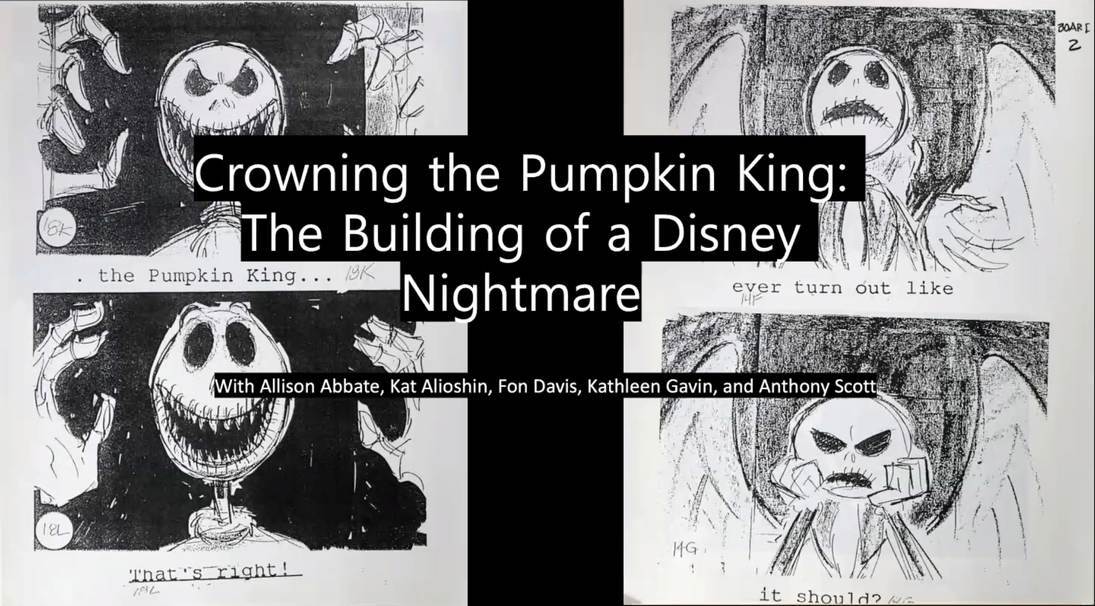Event Recap: “The Nightmare Before Christmas” Crew Share Fun Facts During Walt Disney Family Museum Virtual Event
As a special Halloween treat, the Walt Disney Family Museum hosted a virtual event called “Crowning the Pumpkin King: The Building of a Disney Nightmare” with special guests who worked on Tim Burton’s The Nightmare Before Christmas. This $5 conversation was a perfect way to bridge the gap between the Halloween and Christmas seasons.
The panel included the following guests:
- Allison Abbate - Artistic Coordinator
- Kathleen Gavin - Producer
- Anthony Scott - Animator
- Kat Alioshin - Production Coordinator
- Fon Davis - Set Builder
All of the participants shared fun memories of working on the film in an unassuming warehouse in San Francisco, where they would often retreat to lunch breaks at Rocco’s Cafe. Here are some of the fun things I learned from this presentation.
- In the translation from character and set designs to real world construction, the sculptors had a motto: “If we can’t build it, you can’t have it,” referring to the difficulty of many of the designs. Sally wasn’t designed with socks, but the metal armature hinge in her feet was thicker than the ankles as drawn, so the sculptors added socks to hide the problem.
- Construction on the sets and puppets started before the script was finalized and before they had all of the storyboards ready. As a result, the first sequences put to animation were songs, which had already been written and boarded. The first sequence filmed was “What’s This?” because Christmastown characters and sets were easier to build than Halloweentown elements.
- The production employed almost every stop motion animator in the business, but there was still a shortage of animators compared to the number of characters in the film.
- Sets were sometimes built too big for the animators to work with, who would have to cut them in half to be able to get close enough to the characters to move them.
- Director Henry Sellick didn’t want to use any computer effects and very traditional special effects were used, including pepper’s ghost and double exposure. All of Zero’s scenes were double exposed to make him transparent.
- Computers were used to help map the mouth movements characters would do for the animators as a guide, but the process was still challenging. Jack, for example, had to swap heads for every move of the mouth.
- Curtains were used around each set to block out light made of a material called Duvetyne, which are still in use today on stop motion animated projects.
- Filming was done using old frame-by-frame Mitchell Cameras, which were hard to find. The production team would seek out damaged cameras and repair them to get enough of them for the shoot.
- Because they used real film, animators couldn’t see their dailies until the next day. If anything went wrong, they had to start over on that scene.
- Animators would set up a video camera next to the Mitchell Cameras to try and get a good understanding of what the camera would see, but the parallax meant that they didn’t really know how it would look until the film was viewable.
- The warehouse they filmed in wasn’t temperature controlled and on hot days, pieces of the set would start to melt. If the animators didn’t notice it in time, it would make elements of the set wiggle on film and it would blow the shot.
- Construction on a new prison two blocks away would also cause the warehouse foundation to shake, causing lots of problems for the animators.
- The team used a big board wall with shots arranged in velcro. It was a celebration everytime the crew got to rip a scene off the wall when it was completed.
- Kat Alioshin was asked to do the writing on the “Deadly Nightshade” jars that have become a big merchandise item. She has the original jar that Sally used in the film and the cabinet they were stored in, which she showed during the presentation.
- Many of the members of the crew have cameos in the film on tombstones in the film.
- The crew produced handmade opening credits that were never used where all of the letters were spelled out using pieces of candy corn.
- Tim Burton was too busy to be on the set often, but he did make a point to visit specifically to meet Anthony Scott and thank him for his work when he saw dailies for the “Poor Jack” sequence. Disney had requested that the character be redesigned with eye balls and Burton fought the request. When the dailies came back from that scene, it was clear that the animators could achieve a great amount of expression from him without pupils.
I hope you’ve enjoyed this recap of this extra special Walt Disney Family Museum presentation. The museum will reopen to guests on November 5th. For more information on future Walt Disney Family Museum virtual events, visit their event calendar.



